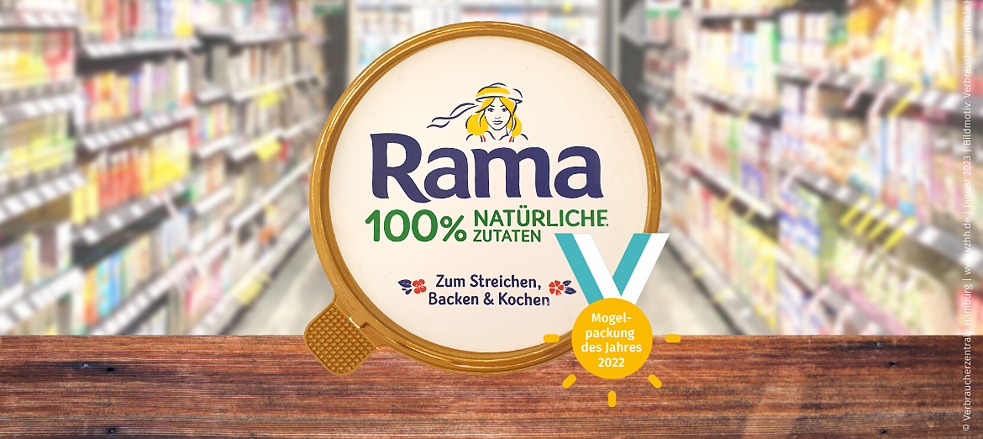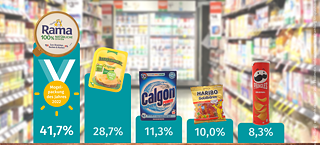Surely it used to contain more? Same pack size, same price, less inside: misleading packaging is annoying. Why manufacturers resort to these unfair methods and what can be done to prevent it.
Surely it used to contain more? Same pack size, same price, less inside: food manufacturers often try to mislead consumers with bigger packaging. Inflation has further accelerated this phenomenon, says consumer protection expert Daniela Krehl in this interview.
 Daniela Krehl is a nutritionist at the Bavarian Consumer Center.
| Photo (Detail): © Verbraucherzentrale Bayern / Marcus Schlaf
Daniela Krehl, what exactly is slack fill?
Daniela Krehl is a nutritionist at the Bavarian Consumer Center.
| Photo (Detail): © Verbraucherzentrale Bayern / Marcus Schlaf
Daniela Krehl, what exactly is slack fill?
Slack fill is a legal term: in law, packaging must not give consumers the impression of a higher product volume. So for example if there is too much air in the packaging, that’s not permitted. But we frequently have this problem: no prosecutor, no judge. In Germany a judge actually does have to decide in each individual case whether slack fill applies to that packaging or not. There are no legal benchmarks to define what slack fill is.
What’s the current situation with regard to slack fill?
Last year, in 2022, we identified a large number of these hidden price increases. The term shrinkflation has been coined to describe this, a portmanteau of shrink and inflation. It’s also very damaging to the environment. A study commissioned by the Federation of German Consumer Organisations says that 1.4 million tonnes of waste could be saved in Germany every year if manufacturers would eliminate slack fill in packaging.
Are there figures to prove that we had more shrinkflation last year in 2022 than usually?
Yes. The Consumer Advice Centre in Hamburg started a monthly award in January 2023, which clearly demonstrated that there have also been more of these hidden price increases in 2022 as a result of the higher food prices.
Can you give an example?
Rama margarine was controversy of the year in 2022. There used to be 500 grammes in a pack. Now it’s only 400 grammes, but the packaging hasn’t changed. Don’t get me wrong, a price increase is more than justified with this product. The ingredients have got more expensive, oil in particular. But our criticism is that it’s a covert price increase: a 20 per cent price hike that isn’t identifiable because the packaging has stayed the same. That’s fraud against the consumers.
 The Hamburg Consumer Protection Center named Rama the shrinkflation package of 2022.
| Photo (Detail): © Verbraucherschutzzentrale Hamburg
Since when has this shrinkflation phenomenon existed?
The Hamburg Consumer Protection Center named Rama the shrinkflation package of 2022.
| Photo (Detail): © Verbraucherschutzzentrale Hamburg
Since when has this shrinkflation phenomenon existed?
It’s not a new thing for manufacturers to sell the same packaging with a lower product volume. We often had that for instance with Pringles, the stacking crisps. Whenever ingredients got more expensive, they kept on changing the number of grammes. But the can never changed size. At one time there were 265 grammes of crisps, and then it was down to 185 grammes. We’re familiar with that sort of thing. But we’re talking about shrinkflation because that sort of thing really seemed to be happening across the board in 2022. We had so many incidences and it involved everything – from gummy bears to laundry detergent.
You say yourself that the ingredients are getting more expensive. But the food industry still has to earn money. Are there situations in which covert price increases are justified?
For us as consumers it’s justified for many reasons if price increases occur. Not just because of the ingredients: energy costs have risen. We have a minimum wage – which means that if food is produced in Germany, there are higher staff costs. There were failed fruit and vegetable harvests as a result of extreme drought. That’s absolutely fine. But what’s happening with shrinkflation is manipulation. The only thing I, as a consumer, can use as a point of orientation is the base price: there’s a legal requirement for supermarkets always to display the price per kg next to the final purchase price. So if I’m well informed, I’ll notice that. But who has time to watch out for that sort of thing? Especially at the moment, when prices are increasing on a daily basis.
What action should the government take to curb shrinkflation?
It’s rare for manufacturers to be held to account for slack fill – because there is no definition of what “slack fill” actually means. We need a law that for instance prescribes that a covert price increase of more than 10 per cent is illegal. Then it would no longer be necessary to negotiate each case individually. It would also be important to specify how much air is permitted to be in a container. For example there should only be an upper limit of 30 per cent empty space in cases where it’s possible to demonstrate a functional reason. Furthermore I’m in favour of labelling price increases of any kind. I’m sure you’re familiar with the way supermarkets label groceries that are reduced or on special offer? We need a similar approach for price increases as well. That would only be fair to consumers.
What else?
Sometimes it makes sense to use larger packaging units. For instance if the manufacturer is providing less content because of a price increase, but they still have 20,000 of the old packs kicking around in the warehouse. But a labelling requirement needs to be introduced for that too. We’re familiar with these labels bearing the legend “Now contains more”. Why don’t we make it compulsory for food manufacturers to write: “Caution, now contains less due to price increase.”
 Only those who compare the price per kilo in the supermarket discover shrinkflation. But who bothers with every product?
| Photo (Detail): © picture alliance/Eibner-Pressefoto/Augst
As a consumer protection expert, you’re also campaigning for labelling of quality changes.
Only those who compare the price per kilo in the supermarket discover shrinkflation. But who bothers with every product?
| Photo (Detail): © picture alliance/Eibner-Pressefoto/Augst
As a consumer protection expert, you’re also campaigning for labelling of quality changes.
Yes. Let’s use “Pesto alla Genovese” as an example. It’s traditionally made from basil, pine nuts, parmesan or pecorino, olive oil, garlic, and salt. However at the moment there’s neither a definition according to food law nor are there set quality requirements for the production of pesto. Some manufacturers substitute the typical ingredients from the original recipe with cheaper ingredients – for instance the often-costlier olive oil with sunflower oil, and pine nuts with cashew nuts. Obviously we can’t expect to get pesto with expensive ingredients for 1.99 euros in the supermarket. But with substitute ingredients the product simply doesn’t match up to general consumer expectations of a traditional Italian pesto.
Do you actually enjoy being a consumer protection expert?
I like being David fighting against Goliath. The food industry has incredible market power and a huge lobby. If manufacturers disguise what’s inside the packaging, then I think consumers need to be protected from that sort of thing. I’m a nutritionist. So I know how complex and important a good, balanced diet is. It’s something every individual should be able to afford and access, without being deceived by the food industry’s shrinkflation tactics. Being convinced of that makes this job ideal for me.
05/2023
